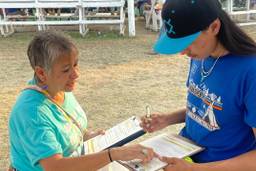The Pandemic Is Exposing the Rotten Core of Our Industrial Food System
While industrial farms have been thrown into chaos, local agriculture has proved to be a more resilient model.
Joseph Bullington
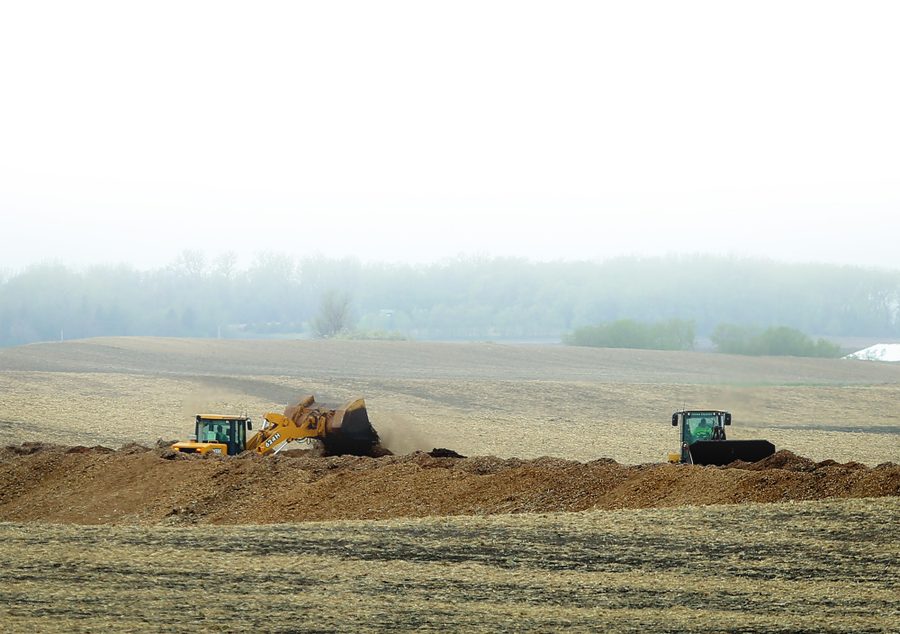
The yellow-brown compost has been heaped into hills taller than the nearby bulldozers. The piles don’t look like pigs, but that’s what they are. Pigs and woodchips.
It’s mid-May and thousands of hogs have been killed and tossed in a woodchipper on this farm field in Nobles County, Minnesota. They represent but a fraction of the number of animals that have met such an end here in the third-highest hog-producing state in the country. The Minnesota Department of Agriculture said on May 6 that at least 10,000 hogs were being slaughtered and discarded every day, but no one knows the real number. The state set up the Nobles County compost site, but it’s not required to track all the killings due to a technicality, says Michael Crusan, communications director for the Minnesota Board of Animal Health. “There isn’t an animal disease issue,” he explains. “It’s just a depopulation due to market conditions.”
“Market conditions” does not mean everyone has enough to eat. In Minnesota and across the country, surging need has overwhelmed food banks. Some supermarkets limit meat purchases to prevent shelves from becoming bare. In the Minneapolis Star Tribune, one letter writer pleads for hunters to be allowed to butcher the wasted hogs, to save at least some of the meat from the woodchipper.
“Market conditions,” in this case, means meat processing plants, including the JBS pork plant in nearby Worthington, have shut down because of Covid-19 outbreaks among workers. The Worthington plant alone, which previously processed 20,000 hogs a day, has been tied to more than 700 Covid-19 cases.
The assembly line of industrial food, however, extends far beyond the processing plants. The closures have left many industrial pig farmers, who raise and ship out hogs on a regimented schedule, with nowhere to send their market-ready animals. With the next batch of hogs ready to fill the cages behind them and no other way to get the meat to hungry people, the farmers have little choice but to grind the animals into compost.
According to John Ikerd, professor emeritus of agricultural and applied economics at the University of Missouri, this failure is not a fluke of the pandemic but a weakness fundamental to the industrial food system. By extending the factory’s fixation on economic efficiency to the farm, industrialism has cut flexibility and diversity out of agriculture. Ikerd says a factory can’t slaughter 20,000 hogs a day, every day, without an inflexible schedule of when hogs are bred, born, fattened and shipped. Just as it’s more efficient to have workers each make a single repetitive cut on an assembly line than it is to have each butcher a whole hog, it’s more efficient to have a farmer raise thousands of hogs in a concentrated animal feeding operation (known as a CAFO) or only grow acres of corn than it is to raise a variety of livestock, chickens and vegetables. Despite some obvious problems, the industrial food system is a marvel of efficiency — until something goes wrong.
Ikerd puts it this way: “We’ve got a more operationally efficient system, but it’s a very fragile system.” Covid-19, he says, is one of many different scenarios that could bring it all crashing down.
Across the country we’ve seen chickens killed en masse, milk dumped, fields of vegetables plowed under. At the same time, we’ve seen the empty shelves, the cars lining up outside food banks.
As the pandemic has shaken the rickety scaffolding of industrial agriculture, it has woken many of us to the fragility of this system — and our dependence on it.
This spring, garden shops across the country sold out of seeds and seedlings. Local farmers and small-scale meat processors saw a surge of interest as people sought alternatives to industrial food. Farms that practice community-supported agriculture (CSA) — a model in which people buy “shares” of a farmer’s harvest at the beginning of a growing season and later receive weekly fresh food boxes — sold out and filled their waiting lists.
The surging interest in local food may not make up all the losses small farms are suffering, but it has been a lifeline for many. And it just might help the country make a long-term shift toward a more sustainable, more resilient and more just food system.

Shared Risk, Shared Reward
In mid-March, about a month before pork plant closures left industrial hog farmers stranded, Minnesota closed public schools—a crucial market for Open Hands Farm in Northfield, Minnesota. Instead of hogs, though, Ben Doherty and Erin Johnson were left holding more than 9,000 pounds of carrots.
Doherty and Johnson grow vegetables for local markets on their small organic farm. Carrot sales to schools account for a large share of their business, so they had to improvise. They explained their predicament on Facebook and offered 25-pound bags of carrots, direct to customers, at wholesale prices. They sold out within a day.
As the weather warmed, it remained unclear when schools would re-open, but Doherty and Johnson had to make decisions about planting. They pushed ahead with their usual crops, planning to find alternative markets if needed. To hedge their bets, they also increased their CSA offerings from 180 shares to 220.
Carrie Sedlak, executive director of the FairShare CSA Coalition based in Madison, Wis., says this “nimbleness” makes local agriculture more resilient than industrial food systems. As Covid-19 lockdowns hit, many of the coalition’s 44 member farms (scattered across Wisconsin, Minnesota, Illinois and Iowa) lost school and restaurant markets and had to lean more heavily on the CSA side of their operations.
The CSA model feels uniquely sturdy in the time of Covid-19. CSAs help small farmers, who operate on thin margins, adapt to shifting markets by putting money in their pockets upfront, when they need it most. The farmers distribute food straight to local people, who can pick up a CSA share outdoors with minimal contact. Most importantly, the model doesn’t paper over the financial risks of farming — it acknowledges them and asks the community to share the burden. If something goes wrong, CSA customers might receive different or fewer items than expected, but their boxes wouldn’t be empty, unlike store shelves during the pandemic.
In exchange for shouldering some of the risk, the participant enjoys a rare kind of food security. “You know the farmer and you know this person grows food locally,” Sedlak says. “It feels more secure than relying on this big, nebulous system.”
For these reasons, Sedlak thinks, CSAs have seen a surge in interest. This spring, all but the biggest farms in the coalition sold out of shares.
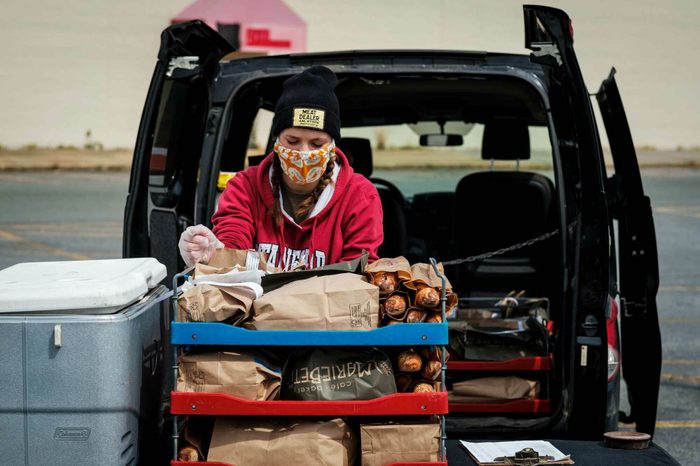

Crisis And Opportunity
When Virginia instituted its stay-at-home order in late March, it closed not only universities, schools and restaurants but also farmers markets, another pillar of local food systems.
“Those closures instilled a lot of panic on farms,” says Kristen Suokko, executive director of Local Food Hub in Charlottesville.
In addition to hardship, Ikerd thinks the food disruptions are creating opportunities for systemic change.
Since the pandemic hit, online grocery sales in the United States have soared. Amazon, Walmart and Target have racked up the vast majority of customers in the past year, but when it comes to selling food online, Ikerd says local producers enjoy significant advantages over food corporations. For example, local farmers can supply fresh food to local customers more efficiently than state or regional operations because they don’t have to spend nearly as much money on transportation, packaging and marketing. (In the current industrial food system, 85 cents of every dollar spent on food goes to marketing while only 15 cents goes to the farmer, according to the U.S. Department of Agriculture.) If local farmers could tap the burgeoning online market rather than battling for room in the mainstream distribution and retail systems, Ikerd says, then local producers and their customers could “totally bypass the industrial food system.”
That’s just what some local food groups have begun to do, out of necessity as much as out of a long-term vision.
Within days of Virginia’s stay-at-home order, Local Food Hub launched drive-thru markets to comply with Covid-19 regulations. Customers could order food online from a variety of local farms and pick it up twice a week.
“Demand was incredible in those first two months,” Suokko says. “Some farmers have said it was the lifeline that kept them going.”
In Wyoming, Slow Food of the Tetons found similar success when it moved its usual year-round farmers market online. Slow Food’s executive director, Scott Steen, says the market, based in Jackson Hole, offers food from 28 farms and saw as many as 200 orders in a good week.
“The online market has sold way more food than we would’ve sold at a winter farmers market,” Steen adds — and it’s served as an essential alternative for local farmers who lost buyers during the pandemic.

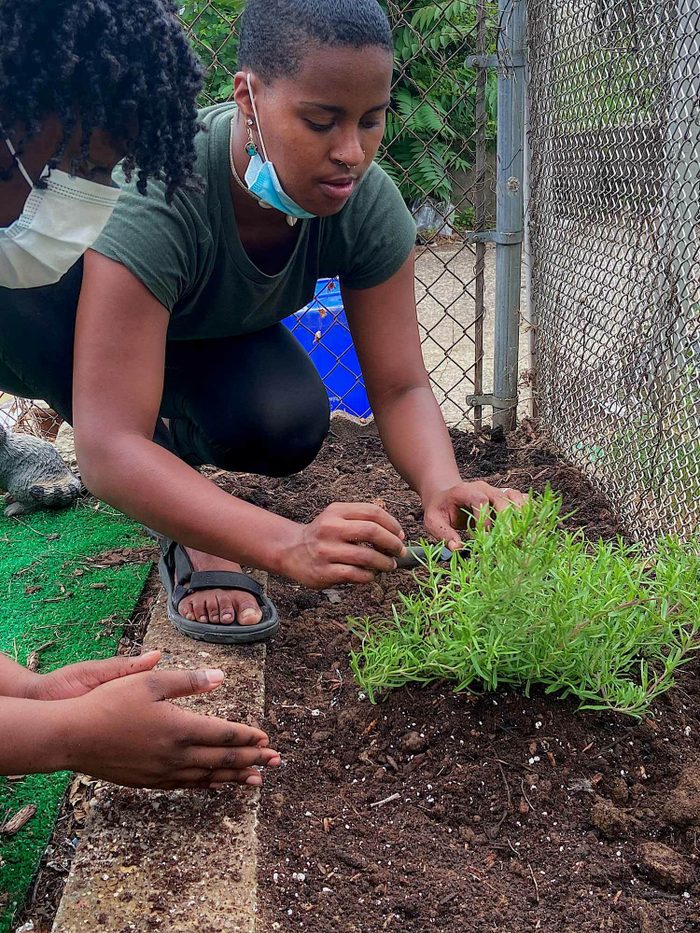
Self-organizing To Feed Each Other
Not every neighborhood, however, has a farmers market — or even a grocery store. Tens of millions of Americans live in food deserts, which are primarily in poor neighborhoods, rural areas and communities of color.
Shania Morris sees this lack of access to food as a kind of violence. Morris is an organizer with Soil Generation, a Black- and brown-led coalition of growers in Philadelphia that fights for food justice and food sovereignty.
“Black people are not only dying at the hands of police,” Morris says. “They are dying because of lack of access to healthy food and healthcare, and because they’re being overworked.
“Our supermarkets and our jobs systems don’t meet the needs of everyone,” Morris says. “In this community, we’re finding ways to do that outside of capitalism.” The group works to shape urban agricultural policy, increase access to land and help neighborhoods build gardens on what land they do have — work that’s become more urgent as people have lost income.
Enlylh King, a Soil Generation coordinator, lives communally and grows food for herself, her friends and her neighborhood. King thinks the pandemic has made people more interested in independence from oppressive systems, including the industrial food chain.
“We don’t want to get to the point where we’re so dependent on this thing that’s so far outside of ourselves that we can’t even take care of ourselves,” King says.
Morris says growing food as a means of building sovereignty is nothing new to Black communities. In 1920, almost a million farms in the United States were Black-owned—14% of all farms. But as systemic racism dispossessed Black communities, that number plunged. As of 2017, only 35,470 farms in the United States were Black-operated—1.7% of all farms.
“We’ve always been needed, we’ve always been here,” Morris says of Black growers. “Now, this moment has shown the truth of what we’ve been saying for a very long time.”
In Minneapolis, the Indigenous-led nonprofit Dream of Wild Health, which runs a 10-acre farm north of the city, partnered with other groups to deliver meals to the Twin Cities Native community during this time of crisis.
Neely Snyder, Dream of Wild Health executive director, says nonperishable food offered by many pantries — while meeting some immediate needs — is “not the healthiest stuff.” She thinks that makes her group’s mission to deliver fresh, healthy, minimally processed foods even more essential.
Every year, the farm distributes more than seven tons of vegetables and fruits by way of youth programs, farmers markets, partnerships with Indigenous chefs and its CSA-style Indigenous Food Share. This spring, as people lost jobs and access to food, Dream of Wild Health planted earlier than usual in anticipation of increased need, says farm manager Jessika Greendeer. Normally, parts of the farm lie fallow, Greendeer says, but this year they planted every available inch with summer squash, cucumbers, corn, tomatoes, winter squash and beans.
Dream of Wild Health makes its food available at less than the “normal farmers market price,” Snyder says. Other local-food nonprofits offer similar programs to make local food more accessible. The FairShare CSA coalition, for example, will pay for half a CSA share for low-income people. Slow Food of the Tetons distributes a localized version of food stamps, and unlike the federal SNAP program, it’s available to undocumented people.
Suokko says this approach has limits. “We’ve been hugely effective at making local food available through philanthropy,” she says. “We’ve not been successful at making it so, if you’re a low-income person, you can go to a local store and buy a local tomato.”
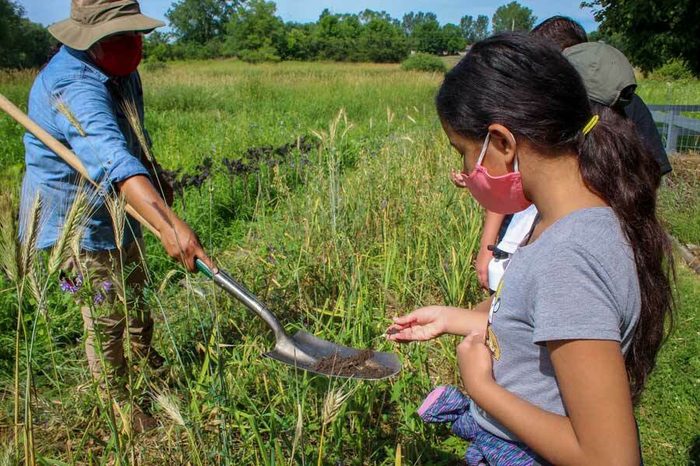

“The Transition Is Already Well Underway”
For local food systems to overgrow the fringes and reclaim a central role in how we eat, we need more farms growing diverse crops and raising animals to feed people who live in their area. And the food needs to be accessible and affordable.
Unfortunately, Sedlak says, “Capitalism tends toward consolidation, not diversification.”
Capitalism is aided by federal farm policy, which funnels assistance and subsidies almost exclusively to big, mono-crop commodity farms. Diversified farms that produce vegetables and fruits, known to the Department of Agriculture as “specialty crops,” do not qualify for federal subsidies or crop insurance.
“The very fact that fruits and vegetables are labeled ‘specialty crops’ in USDA parlance tells you everything,” Suokko says. Only 2% of U.S. farmland grows fruits and vegetables while almost 60% grows commodities like soybeans and corn. Some of those sprawling fields will eventually have to be restored and diversified, unless we want to plow what little is left of the American grasslands. (Which isn’t much: In Illinois, for example, only 2,500 acres of prairie remain, of an original 22 million.)
North of Minneapolis, Dream of Wild Health is scaling up. Before the state’s lockdown order took effect, the group purchased an additional 20-acre farm. Greendeer and her team are busy restoring the land, which has been in mono-crop corn rotations the past two seasons. She hopes it will be ready for planting in 2021.
According to Ikerd, the federal farm support system should stop subsidizing the industrial food system and instead support small, diversified farms, along with those conventional farmers who are able to transition. “If,” he says, “they still remember how to manage a farm rather than a biological factory.” We are also, Ikerd says, going to have to “grow a lot of new farmers” and give them access to land.
According to Sedlak, the main barriers that keep people from farming are a lack of access to affordable land and a lack of capital to start. Not all farmers have access to grants and donations, which is how Dream of Wild Health, for example, funded its expansion. The need is particularly great in Black communities, Indigenous communities and others that have been systematically deprived of access to land and sovereignty over their food.
We have become so dependent on the industrial food system that it’s difficult to imagine a world without it, but Ikerd takes a more optimistic view. “The transition to the new local, sustainable food systems is already well underway,” he says. “We just need government policies and public institutions to support it.”
Joseph Bullington grew up in the Smith River watershed near White Sulphur Springs, Montana. He is the editor of Rural America In These Times.



